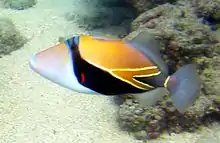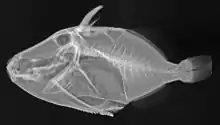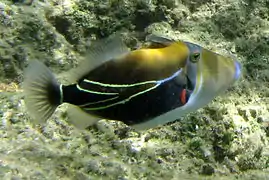Reef triggerfish
The reef triggerfish (Rhinecanthus rectangulus), also known as the rectangular triggerfish, wedgetail triggerfish,[1] or by its Hawaiian name humuhumunukunukuāpuaʻa (pronounced [ˈhumuˈhumuˈnukuˈnukuˈwaːpuˈwɐʔə], meaning 'triggerfish with a snout like a pig'[2]), also spelled humuhumunukunukuapua'a or just humuhumu for short, is one of several species of triggerfish. It is found at reefs in the Indo-Pacific[3] and is the state fish of Hawaii.
| Reef triggerfish | |
|---|---|
 | |
| Adult in Hanauma Bay, Hawaii | |
 | |
| Rhinecanthus rectangulus, X-ray image | |
| Scientific classification | |
| Kingdom: | Animalia |
| Phylum: | Chordata |
| Class: | Actinopterygii |
| Order: | Tetraodontiformes |
| Family: | Balistidae |
| Genus: | Rhinecanthus |
| Species: | R. rectangulus |
| Binomial name | |
| Rhinecanthus rectangulus (Bloch & J. G. Schneider, 1801) | |
The name humuhumunukunukuāpuaʻa serves for both singular and plural descriptions. The fish shares its Hawaiian name with the lagoon triggerfish (R. aculeatus), another fish also found in the Indo-Pacific.
Description
The triggerfish's teeth and top lip are blue and the teeth are set close together inside its relatively plump mouth.
The fish has a small second dorsal spine, which is used to lock its main spine into an upright position. This locking of its spine while sheltering inside a small crevice helps protect the fish against being extracted by a predator. When fleeing from predators, the triggerfish will sometimes make grunting noises, possibly a call to warn other nearby triggerfish of danger.[4]
The triggerfish can blow jets of water from its mouth, which help the fish find benthic invertebrates that may be buried under the substrate. Triggerfish can often be seen spitting sand from their mouths in order to sift through the material in search of edible detritus or organisms.
Reef triggers, up to 30 cm in length, are fairly aggressive and will generally not tolerate conspecific individuals in their general vicinity; thus the fish is often solitary. This is particularly true in captivity. Triggers have the ability to rapidly alter their coloration. They can fade into a relatively drab appearance when sleeping or demonstrating submission, while their coloration is often the most vivid when the fish are healthy and unthreatened by their surroundings. They have also been known to bite and attack swimmers in their area, often around the ankle, sometimes leaving marks.
.jpg.webp) Juvenile reef triggerfish
Juvenile reef triggerfish Adult in Hāʻena State Park
Adult in Hāʻena State Park.jpg.webp) The lagoon triggerfish, which shares the Hawaiian name humuhumunukunukuapuaʻa with the reef triggerfish.
The lagoon triggerfish, which shares the Hawaiian name humuhumunukunukuapuaʻa with the reef triggerfish.
Hawaii state fish
The reef triggerfish was originally designated the official fish of Hawaii in 1985,[5] but due to an expiration of a Hawaiian state law after five years, it ceased to be the state fish in 1990.[6] On April 17, 2006, bill HB1982 was presented to the Governor of Hawaiʻi, which permanently reinstated the reef triggerfish (humuhumunukunukuāpuaʻa) as the state fish of Hawaii.[7] The bill passed into law on May 2, 2006, and was effective upon its approval.[8][9]
Decades prior to official recognition, humuhumunukunukuāpuaʻa were considered a symbol of Hawai'i. The song My Little Grass Shack in Kealakekua, Hawaii includes the line " . . .where the humuhumunukunukuāpuaʻa go swimming by . . ."
References
- "Wedgetail Triggerfish - Rhinecanthus rectangulus - Triggerfishes - Reef Triggerfish - Hawaii Reefs". reefguide.org. Retrieved 2020-03-01.
- humuhumunukunukuapua'a. humuhumunukunukuapua'a. (n.d.) American Heritage® Dictionary of the English Language, Fifth Edition. (2011). Accessed on The Free Dictionary. Retrieved on 2015-05-18.
- Froese, Rainer and Pauly, Daniel, eds. (2005). "Rhinecanthus rectangulus" in FishBase. December 2005 version.
- April True or Fool Quiz. Maui Ocean Center (2015-03-31). Retrieved on 2015-05-18.
- Hawaiian Bill 1982 Retrieved 2011-05-17
- "Lawmaker seeks official status for humuhumunukunukuapuaa". USA Today. January 1, 2006. Retrieved May 22, 2010.
- HB1982 Measure History. Capitol.hawaii.gov. Retrieved on 2015-05-18.
- House Bill. Capitol.hawaii.gov. Retrieved on 2015-05-18.
- Hawaii may honor long-named fish - Weird news. NBC News (2006-04-18). Retrieved on 2015-05-18.
Further reading
| Wikimedia Commons has media related to Rhinecanthus rectangulus. |
- "Rhinecanthus rectangulus". Integrated Taxonomic Information System. Retrieved 30 January 2006.
- "Marine Life Profile: Reef Triggerfish" (PDF). Waikiki Aquarium. Retrieved 24 November 2011.
- "Legislation to permanently establish as Hawaii state fish". Archived from the original on 10 July 2006. Retrieved 28 January 2006.
- "Hawaii may honor fish with long name". Retrieved 18 April 2006.
External links
- Photos of Reef triggerfish on Sealife Collection